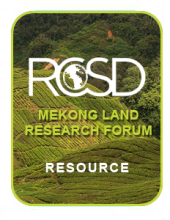Land Library
Welcome to the Land Portal Library. Explore our vast collection of open-access resources (over 74,000) including reports, journal articles, research papers, peer-reviewed publications, legal documents, videos and much more.
/ library resources
Showing items 1 through 9 of 89.This paper deepens the economic analysis of the effects of land consolidation – reduction of land fragmentation.
Between Vietnam's independence and its reunification in 1975, the country's socialist land tenure system was underpinned by the principle of "land to the tiller". During this period, government redistributed land to farmers that was previously owned by landlords.
Increasing global demand for natural rubber began in the mid-2000s and led to large-scale expansion of plantations in Laos until rubber latex prices declined greatly beginning in 2011. The expansion of rubber did not, however, occur uniformly across the country.
Access to credit and its cost is a major challenge for farmers in developing countries. Several studies show that land serves as collateral for accessing formal credit, but they often do not find any significant effect of land size on access to informal credit.
We estimate whether a land reform program led to higher incomes for ethnic minority households. In 2002, in the Central Highlands of Vietnam, Program 132 directed the transfer of farm land to ethnic minority households that had less than one hectare of land.
Agricultural large-scale land acquisition (LSLA) is a process that is currently not captured by land change models. We present a novel land change modeling approach that includes processes governing LSLAs and simulates their interactions with other land systems.
ABSTRACTED FROM EXECUTIVE SUMMARY: During the critical years following the 2012 land reforms undertaken in the midst of Myanmar’s political transition, Gret conducted an in-depth study combining qualitative and quantitative surveys in nine villages of Bogale and Mawlamyinegyun townships (Delta) a
The objective of this background paper is to provide a succinct description of the land tenure situation in Cambodia and, on that basis, discuss the needs smallholder farmers have for land, projected up to the year 2030.
ABSTRACTED FROM EXECUTIVE SUMMARY: Land rights systems in Southeast Asia are in constant flux; they respond to various socioeconomic and political pressures and to changes in statutory and customary law.

